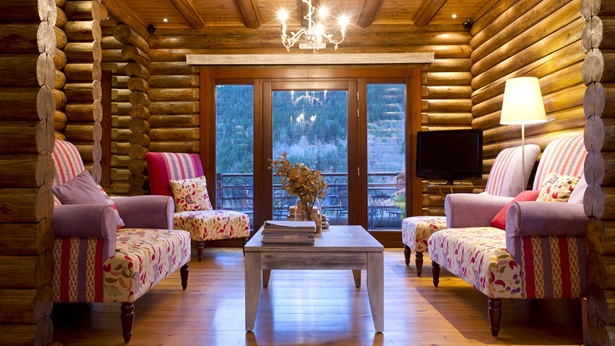Log Profiles and Corner Styles
At first glance, you may think there isn’t much difference between one log and another. Seen one tree and you’ve seen them all, right? Well, you’re in for a bit of a surprise. There are more corner styles, profiles and sizes in the modern log and timber home industry than you can shake a stick at.
More than 17 tree species are used, each with its own unique physical characteristics. This can include the color of the wood, size (diameter & length), grain pattern, thermal performance and resistance to decay. Plus, logs can be fashioned into a host of different corner styles and profiles, using different crafting and milling techniques.
How do you decide which style is right for you? Just as with deciding on the design of a conventional home, it’s often a matter of personal preference. But it’s important to understand your choices. That’s why the Log and Timber Homes Council created The Perfect Path to Your Dream Home, to educate consumers on their options. Use these tips and tactics to sort out which log wall style is right for you.
Protect Your Investment
While there are hundreds of log and timber home companies to choose from in the United States and Canada, only a few dozen qualify for membership in the Log and Timber Homes Council. Why so few? The Log and Timber Homes Council membership requirements protect consumers during the buying and building process. But don’t think that limiting yourself to Council members limits your design choices. Council members, in total, offer every log style used today in log and timber home construction.
Are Logs and Timbers Graded?
To ensure your home is constructed with quality building materials, only buy logs and timbers that are graded by a third party agency. The good news is that all Log and Timber Homes Council members grade their logs — it’s part of the membership requirements for joining the council. You can tell if logs are graded by stamps that are printed on logs. The stamps will be either from the Log and Timber Homes Council or Timber Products Inspection (TPI).
Graded Logs Often Required to Meet Building Codes
Bear with us, we’re about to get all technical here. The grading rules and subsequent design values used by the grading agencies are based on the nationally recognized Standard ASTM D3957 “Standard Methods for Establishing Stress Grades for Structural Members Used in Log Buildings.” Grading programs ensure the logs are timbers are accepted for use in home building by the International Code Council, the U.S. Dept. of Housing and Urban Development and many regional and local building codes.
General Categories of Log and Timber Styles
Since most companies specialize in one particular style, the process of elimination should start with what you find attractive. Start by viewing council members’ photo galleries. You should also visit completed homes, to grasp how the visual and aesthetic impact of log walls affect the feel of the home.
How to Tell Styles Apart
Milled or Manufactured
What’s a milled log and timber home look like? Look for uniformity in the profiles and diameters, especially at the corners where the logs intersect. About 90% of all modern log and timber homes built today are milled or manufactured. Using high speed milling machines, harvested trees or squared cants are milled to a specific profile (D-log, round log, etc.). Depending on the company and its building system, this milling procedure can include precutting of each log to fit a particular home design.
Handcrafted
What do handcrafted logs look like? Detect these by noticing larger logs with varying diameters at corners or along the length of the wall. Handcrafted logs can also display a hand-hewn appearance or exhibit wide bands of chinking between log courses (milled logs can employ chinking as well, either decorative or structural). Handcrafted homes account for about 10% of all modern log and timber homes constructed annually. Some members of the Log and Timber Homes Council offer both milled and handcrafted logs.
Half-Log Siding
A conventional 2-by-4 or 2-by-6 frame for a home can be wrapped inside and out with half-log siding (or tongue-and-groove paneling on the interior). Exterior corner sections can be full log to maintain the illusion. Log siding are used in full-log construction as well, on dormers, garages and outbuildings.
Post and Beam or Timber Frame
This style includes large horizontal or vertical beams on the interior of the home (think large vaulted ceilings with open interior areas). Beams can either be handcrafted or milled.
Log Profiles
A log profile determines how logs stack up in a wall system. The profile of each log is both structural (load-bearing surface) and aesthetic (design shape). Home buyers have a number of options. Which profile performs best? All work well when constructed to a log and timber home producer’s specifications and construction manual. Which profile is the most popular? Whichever one strikes your fancy. Here are your options:
D-Log
A flat interior wall with a rounded appearance on the exterior, D-Logs are popular in the log and timber home industry. Many home buyers like the symmetry of flat interior walls, with the rustic round appearance on the exterior. D-Logs can come in a variety of sizes, depending on the log and timber home manufacturer. D-Logs can be used with a variety of corner styles. Illustration courtesy of LHA Inc.
Full Round on Round
This log profile (also called Swedish-cope, saddle-cope or round-notch) can be employed with either milled or handcrafted logs. This profile also comes in more than one dimension, including 8-12-inch in diameter or larger. It is typically combined with saddle-notch corners. It gets its name from the saddle-like notch milled into the bottom of each round log.
Milled Round on Round
This is for buyers that prefer the round look on both the inside and the outside of the home. This illustration includes tongue-and-groove joinery on the horizontal interfaces. There are single, double and triple tongue-and-groove joinery used in the log and timber home industry.
Square or Rectangular
Although once associated with an Appalachian-style log designs, square or rectangular log profiles are now popular regardless of the region where the home is being built. Logs produce flat interior and exterior walls. Decorative chinking, wide bands of flexible material, can be added to this profile. This profile is typically combined with dovetail corners or corner post design. Illustration courtesy of LHA Inc.
Beveled or Shiplap
A beveled or shiplap style is a slight variation of square or rectangular log, with an edge that helps shed moisture. This can be combined with corner post joinery. Illustration courtesy of LHA Inc.
Corner Styles
Corner types fall into several categories, each with its own charm and functionality for keeping Mother Nature at bay.
Butt-and-Pass Corner
In this corner and wall style, one log stops (butts) and the other extends (pass) the corner. There are dozens of variations of this corner system, all involving the shape of area where the logs meet at the corner. In many, passing logs have a cutout, or mortise, into which the butted log is inserted. If the end of the butting log is shaped to fit the mortise, it is called a tenon (also known as mortise-and-tenon joinery or a V-joint).
Dovetail Corner
Used primarily with square or rectangular logs, each log is cut to produce a fan-shaped wedge. As each course of logs are stacked, the log ends lock into each other.
Saddle-Notch Corners
The notch on the bottom of each round log straddles the one below it. Both logs then extend past the corner.
Swedish-Cope Corner
A variation on the saddle notch, the Swedish Cope corner style is often employed in handcrafted log and timber homes.
Corner Post
This style looks distinctly different than the other over-lapping corner styles. In this corner system, logs up against a corner post.
Passionate Pursuit of Perfection
When shopping for a log and timber home, many buyers set out to discover which company has the best profile, corner style, tree species or building system on the market. After much time devoted to detailed research, they discover that perfection is more elusive than a winning powerball ticket. Truth is, there isn’t a single best profile, corner style or tree species. (If there were, every company would be offering that same style.) Our advice is to narrow down which log profile and corner style you like, then put your energy into creating the perfect floor plan for your lifestyle. Then have several companies competitively bid on which ever profile and corner style you prefer.
So follow your intuition and have fun researching your options. The sooner you decide what exactly what look you love, the sooner you will move down that Perfect Path to Your Dream Home.



